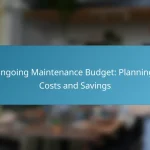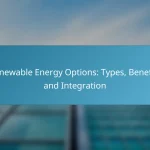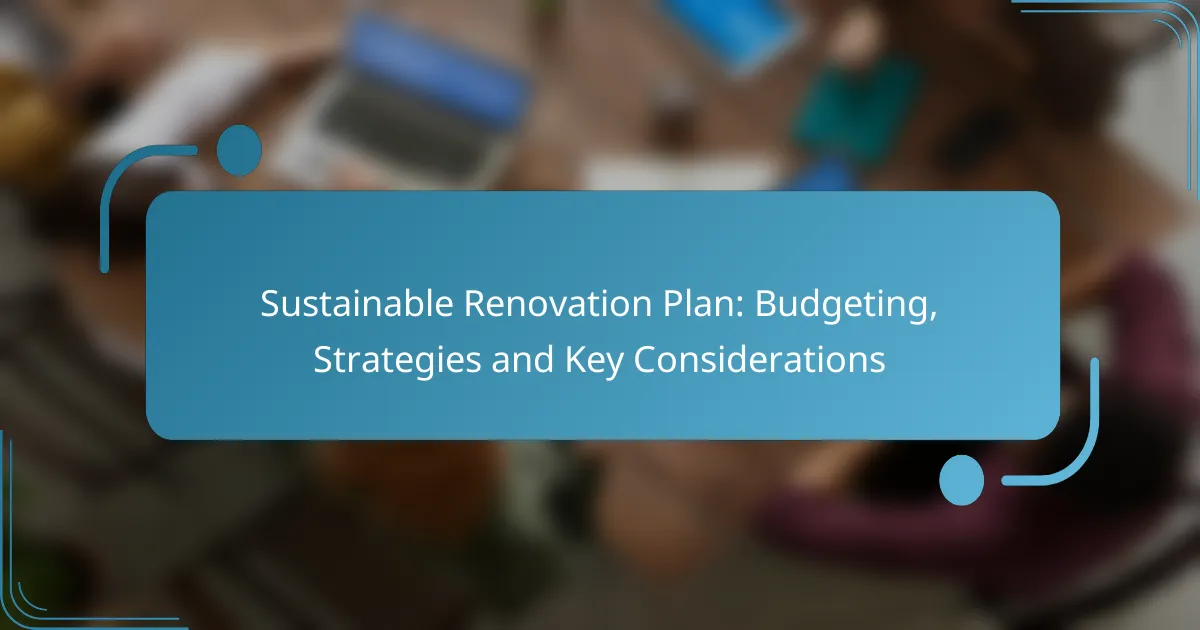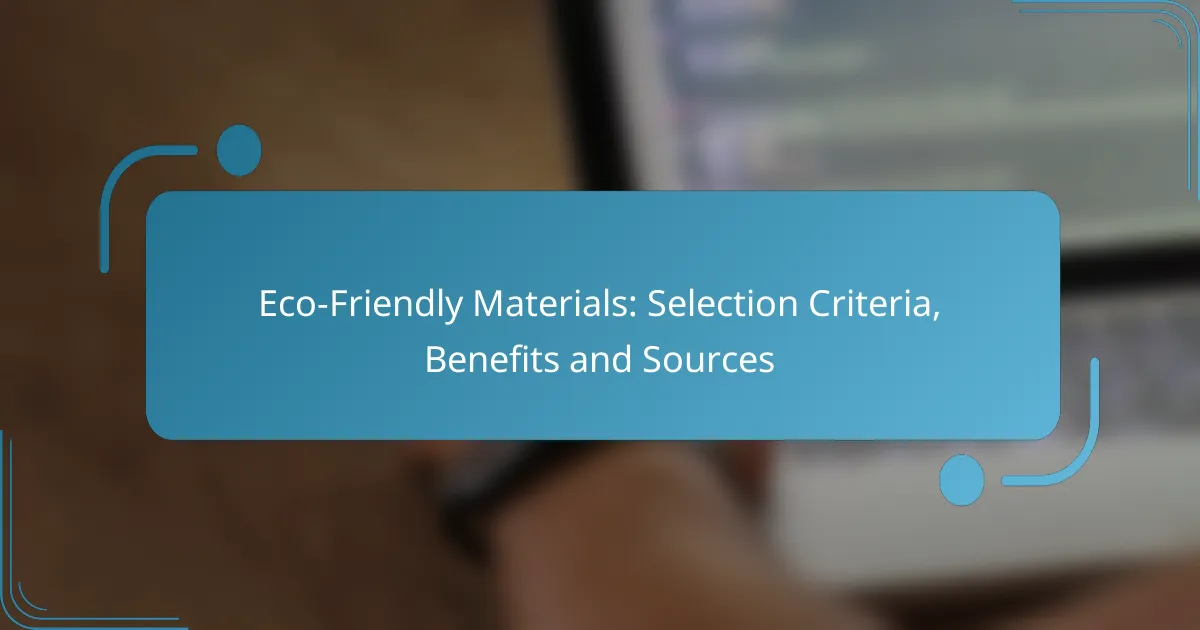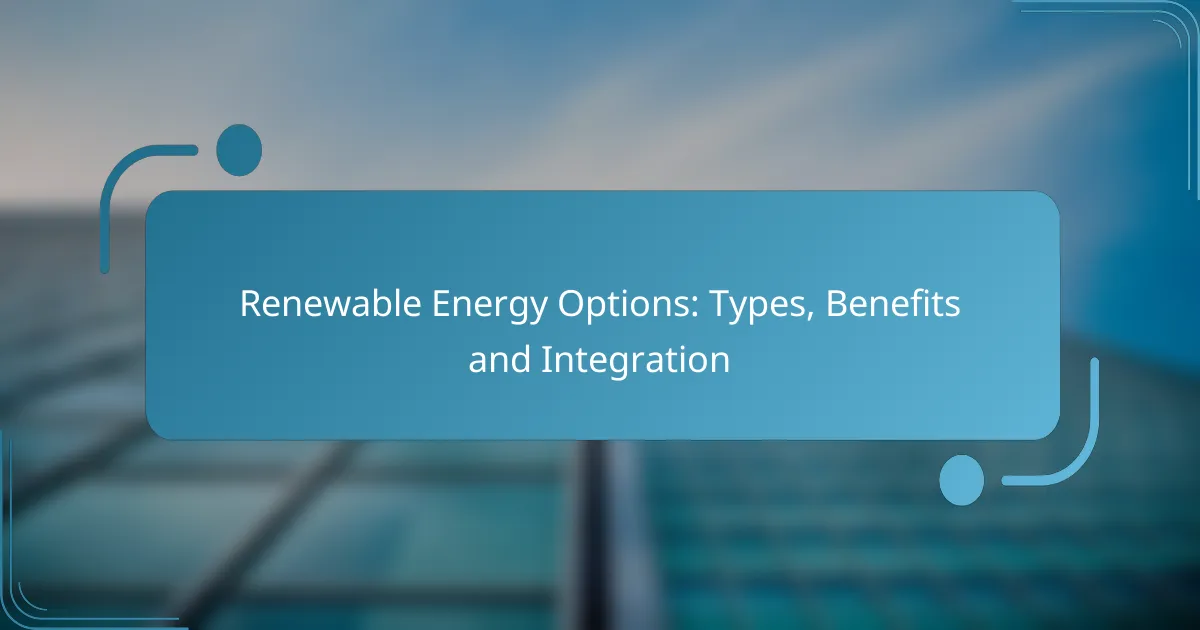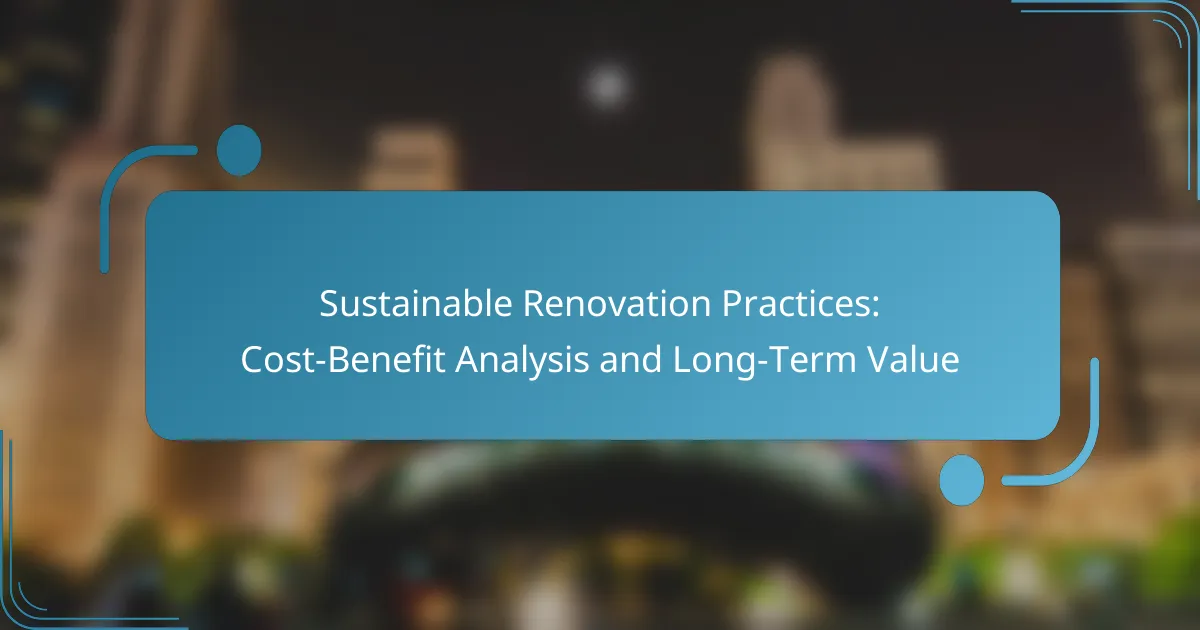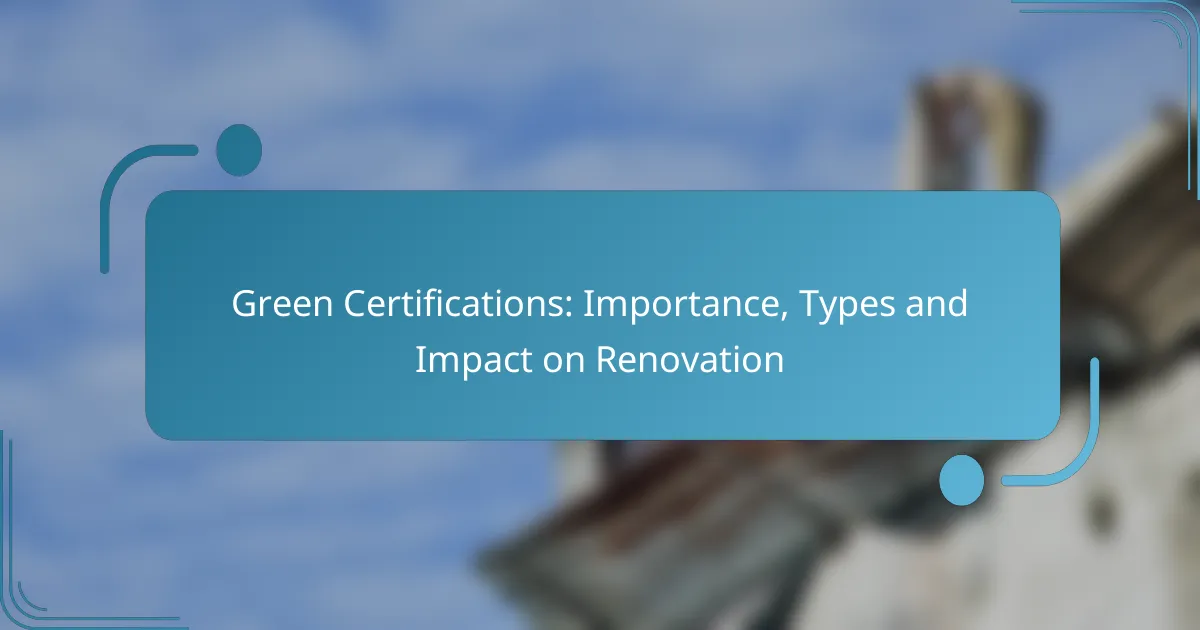A sustainable renovation plan requires a strategic approach to budgeting, ensuring that eco-friendly practices are both effective and financially feasible. By focusing on accurate cost estimation, diverse funding sources, and the long-term benefits of sustainable choices, homeowners can make informed decisions. Additionally, selecting sustainable materials and prioritizing energy efficiency are crucial for minimizing environmental impact while enhancing the functionality and durability of renovations.
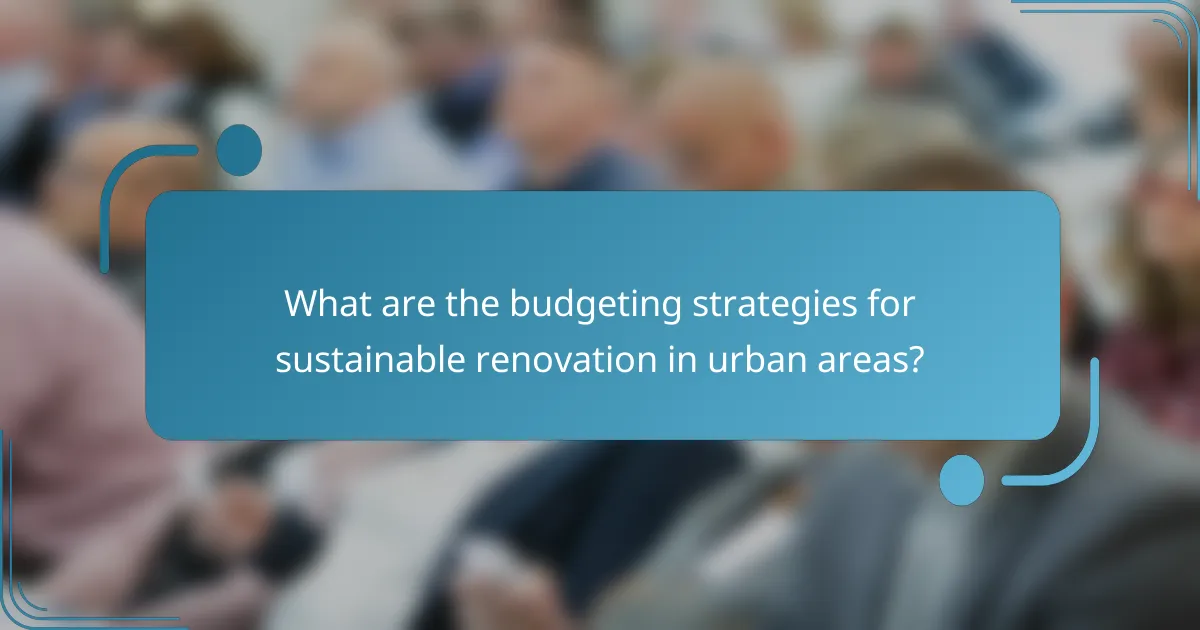
What are the budgeting strategies for sustainable renovation in urban areas?
Budgeting for sustainable renovation in urban areas involves careful planning and resource allocation to ensure eco-friendly practices are financially viable. Key strategies include accurate cost estimation, exploring diverse funding sources, and understanding the long-term financial benefits of sustainable choices.
Cost estimation techniques
Effective cost estimation techniques are crucial for budgeting sustainable renovations. Start by assessing the current condition of the property and identifying necessary upgrades, such as energy-efficient windows or insulation. Utilize tools like cost calculators or consult with contractors to obtain accurate quotes.
Consider breaking down costs into categories such as materials, labor, and permits. This approach helps prioritize spending and identify areas where you can save, such as opting for recycled materials or local suppliers to reduce transportation costs.
Funding sources for eco-friendly projects
Various funding sources are available for eco-friendly renovation projects in urban areas. Government grants and incentives often support energy-efficient upgrades, so check local regulations for available programs. Nonprofit organizations may also offer funding for projects that promote sustainability.
Additionally, consider green loans or financing options specifically designed for sustainable renovations. These often come with lower interest rates and favorable terms, making it easier to manage upfront costs while investing in long-term savings.
Long-term financial benefits
Investing in sustainable renovation can yield significant long-term financial benefits. Energy-efficient upgrades typically lead to lower utility bills, with potential savings of 20-30% over time. This reduction can offset initial renovation costs and improve property value.
Moreover, sustainable properties often attract environmentally conscious buyers or tenants, enhancing marketability. In urban areas, where demand for green living spaces is rising, this can lead to higher rental rates and increased property appreciation.
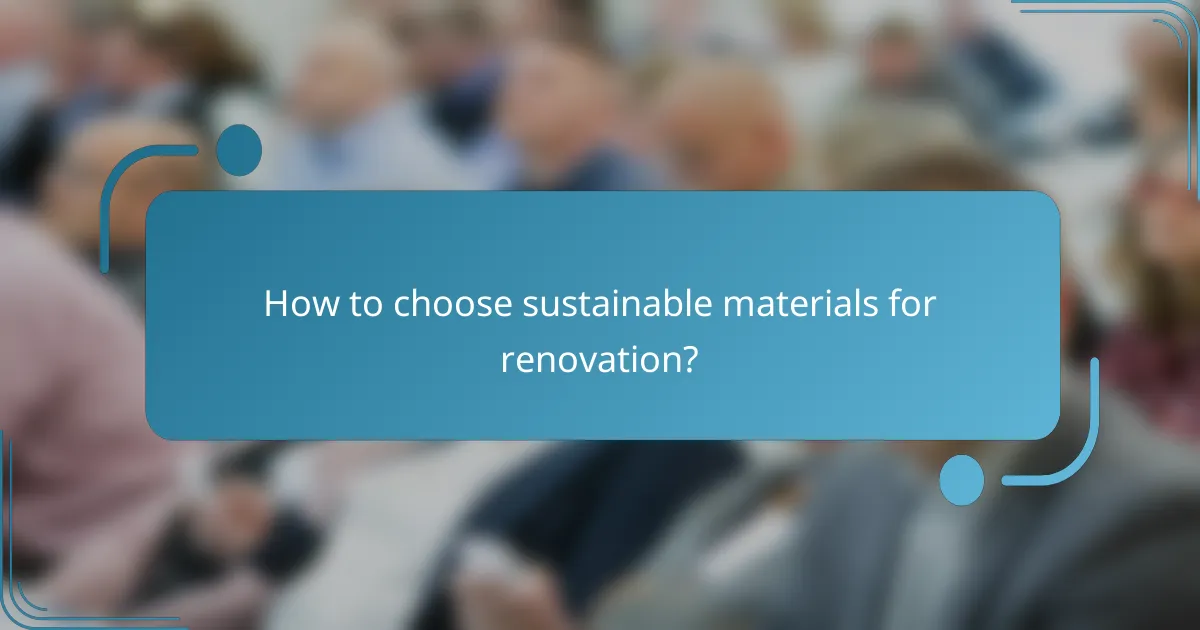
How to choose sustainable materials for renovation?
Choosing sustainable materials for renovation involves selecting products that minimize environmental impact while ensuring durability and functionality. Key factors include sourcing renewable resources, reducing waste, and considering the energy efficiency of materials throughout their lifecycle.
Eco-friendly material options
When selecting eco-friendly materials, consider options such as bamboo, reclaimed wood, recycled metal, and low-VOC (volatile organic compounds) paints. These materials not only reduce environmental harm but often provide unique aesthetics and durability. For instance, bamboo grows rapidly and can be harvested sustainably, making it a popular choice for flooring and cabinetry.
Additionally, look for certifications like FSC (Forest Stewardship Council) for wood products or Energy Star ratings for appliances to ensure that the materials meet environmental standards. These certifications can guide you in making informed choices that align with sustainability goals.
Local suppliers for sustainable materials
Finding local suppliers for sustainable materials can significantly reduce transportation emissions and support the local economy. Search for businesses that specialize in eco-friendly products, such as local lumber yards that offer reclaimed wood or stores that stock sustainable insulation materials. Engaging with local suppliers often leads to better pricing and personalized service.
Consider visiting local markets or trade shows focused on sustainable building practices to discover new suppliers and products. Networking with local builders and contractors can also provide recommendations for reliable sources of sustainable materials in your area.
Material lifecycle assessments
Conducting a material lifecycle assessment (LCA) helps evaluate the environmental impact of materials from extraction to disposal. This process involves analyzing factors such as energy consumption, emissions, and waste generation associated with each material. Understanding these impacts can guide you in selecting options that align with your sustainability objectives.
When performing an LCA, consider using tools or software designed for this purpose, which can provide detailed insights into the environmental footprint of various materials. This assessment can help you make informed decisions that not only benefit the environment but also enhance the overall quality and longevity of your renovation project.

What are the key considerations for energy efficiency?
Key considerations for energy efficiency include selecting appropriate appliances, implementing effective insulation techniques, and integrating renewable energy sources. These factors significantly impact energy consumption and can lead to substantial cost savings over time.
Energy-efficient appliances
Energy-efficient appliances are designed to consume less energy while providing the same level of performance as standard models. Look for products with the ENERGY STAR label, which indicates compliance with strict energy efficiency guidelines. Common examples include refrigerators, washing machines, and dishwashers that can reduce energy usage by 10-50% compared to older models.
When budgeting for these appliances, consider the initial purchase price alongside potential long-term savings on utility bills. While energy-efficient models may cost more upfront, the return on investment can be realized within a few years through lower energy costs.
Insulation techniques
Effective insulation techniques help maintain comfortable indoor temperatures and reduce heating and cooling costs. Key areas to focus on include attics, walls, and floors. Materials such as fiberglass, foam board, and spray foam can significantly enhance thermal resistance.
To ensure optimal performance, check for gaps and leaks around windows and doors, which can undermine insulation efforts. A well-insulated home can save homeowners 20-30% on heating and cooling expenses, making it a crucial consideration in any renovation plan.
Renewable energy integration
Integrating renewable energy sources, such as solar panels or wind turbines, can further enhance energy efficiency by reducing reliance on traditional power sources. Solar energy systems can provide a substantial portion of a home’s electricity needs, especially in sunny regions, and can lead to significant savings on energy bills.
When considering renewable energy, assess local incentives, rebates, and regulations that may impact installation costs and potential savings. Many homeowners find that with the right financing options, the upfront investment can be offset by long-term energy savings and increased property value.
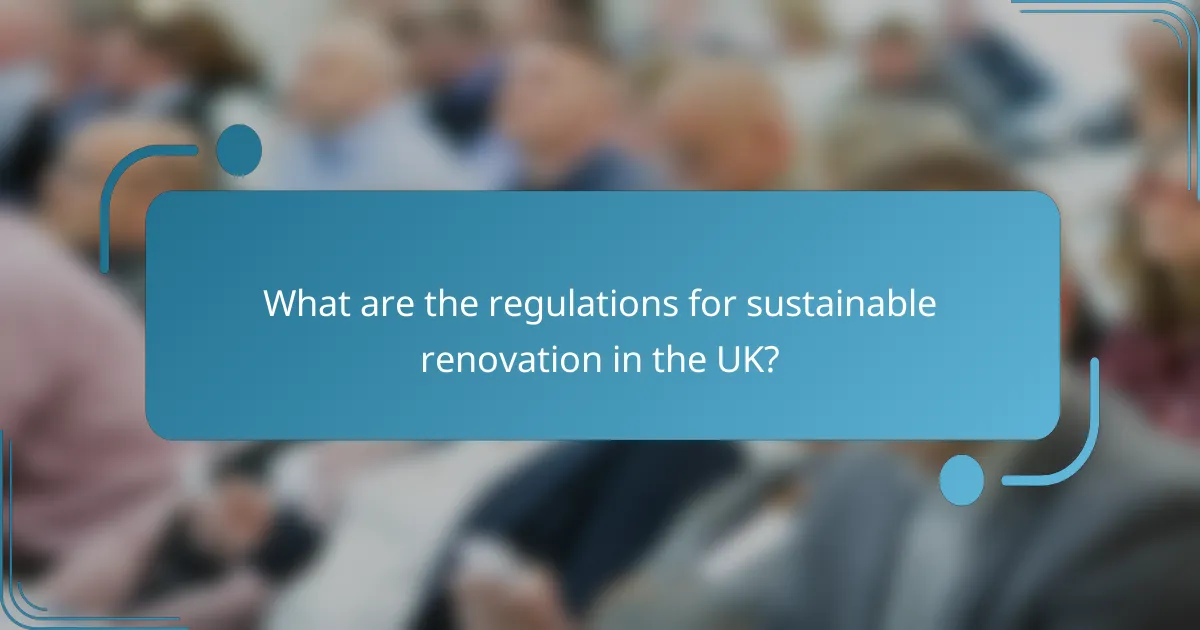
What are the regulations for sustainable renovation in the UK?
In the UK, sustainable renovation regulations focus on energy efficiency, environmental impact, and building safety. These regulations ensure that renovations meet specific standards to promote sustainability and reduce carbon emissions.
Building codes and standards
Building codes in the UK require that renovations comply with the Building Regulations, which set minimum standards for design and construction. Key areas include energy performance, fire safety, and accessibility. The Energy Efficiency (Private Rented Property) (England and Wales) Regulations also mandate that rental properties meet certain energy efficiency ratings.
For sustainable renovations, adhering to standards like BREEAM (Building Research Establishment Environmental Assessment Method) can enhance the building’s environmental performance. This certification evaluates the sustainability of a building’s design, construction, and operation.
Permitting processes
Before starting a sustainable renovation, obtaining the necessary permits is crucial. Most renovations require planning permission, particularly if they affect the building’s structure or external appearance. Local councils provide guidelines on what requires permission and the application process.
It’s advisable to consult with local authorities early in the planning stage to ensure compliance with all regulations. This can help avoid delays and additional costs associated with non-compliance.
Incentives for green building
The UK government offers various incentives to encourage sustainable renovations. These include grants, tax reliefs, and funding programs aimed at improving energy efficiency. For instance, the Green Homes Grant allows homeowners to claim vouchers for energy-efficient improvements.
Additionally, businesses may benefit from the Enhanced Capital Allowance scheme, which provides tax relief for investments in energy-saving equipment. Understanding these incentives can significantly reduce renovation costs while promoting sustainability.
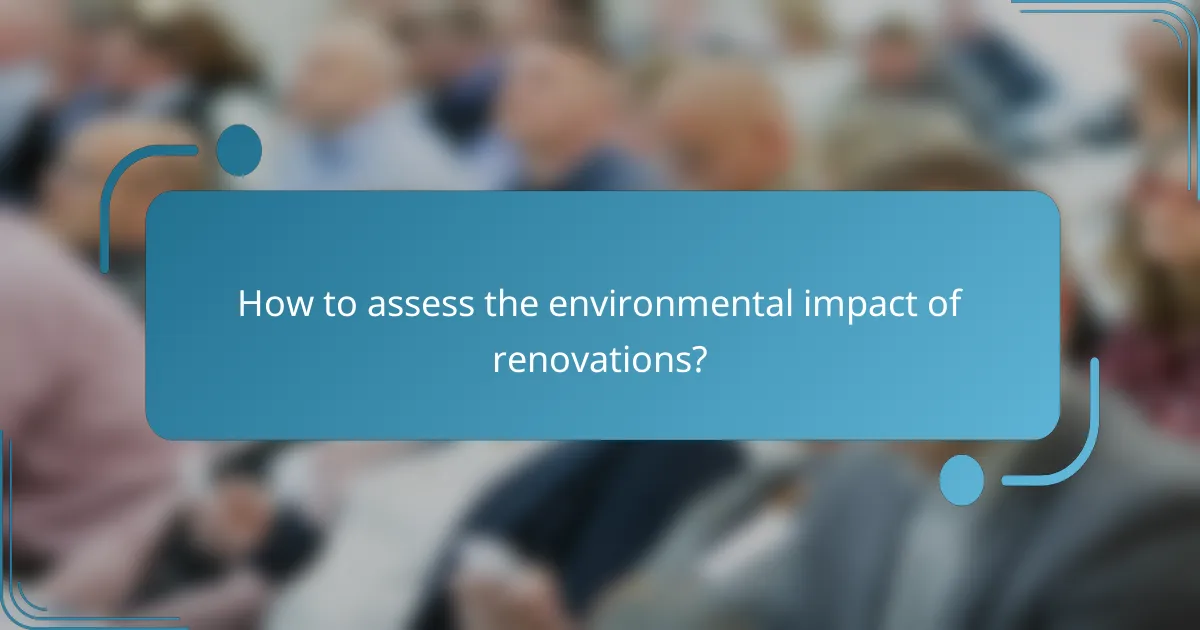
How to assess the environmental impact of renovations?
To assess the environmental impact of renovations, consider evaluating the materials used, energy consumption, and waste generated during the process. This assessment helps identify areas for improvement and guides sustainable practices throughout the renovation project.
Environmental impact assessments
Environmental impact assessments (EIAs) are systematic processes that evaluate the potential effects of a renovation project on the environment. They typically involve analyzing factors such as air and water quality, biodiversity, and land use. Conducting an EIA can help identify negative impacts early, allowing for adjustments to minimize harm.
In many regions, EIAs are required by law for larger projects. Familiarize yourself with local regulations to ensure compliance and to leverage available resources for conducting a thorough assessment.
Carbon footprint calculations
Calculating the carbon footprint of renovations involves estimating the total greenhouse gas emissions associated with materials, construction processes, and energy use. This calculation can guide decisions on sustainable materials and energy-efficient practices. Tools and calculators are available online to assist in estimating these emissions.
Consider using low-carbon materials, such as recycled or sustainably sourced products, to reduce your renovation’s carbon footprint. Additionally, implementing energy-efficient systems can significantly lower emissions over the lifespan of the building.
Waste management strategies
Effective waste management strategies during renovations focus on reducing, reusing, and recycling materials. Start by conducting a waste audit to understand what materials will be generated and identify opportunities for diversion from landfills. Aim to minimize waste through careful planning and material selection.
Consider donating usable items or materials to local charities or recycling centers. Establish a clear plan for disposal that aligns with local regulations, and educate your team on best practices to ensure compliance and sustainability throughout the renovation process.

What are the trends in sustainable renovation practices?
Sustainable renovation practices are increasingly focused on energy efficiency, eco-friendly materials, and waste reduction. These trends aim to minimize environmental impact while enhancing the comfort and value of homes and buildings.
Energy Efficiency Improvements
Energy efficiency is a cornerstone of sustainable renovation, often achieved through upgrades like better insulation, energy-efficient windows, and modern heating and cooling systems. Homeowners can expect to reduce energy consumption significantly, often by 20-30%, leading to lower utility bills.
Consider implementing smart home technology, such as programmable thermostats and energy monitoring systems, which can optimize energy use further. Additionally, look for appliances with high energy ratings to ensure long-term savings and reduced environmental impact.
Use of Eco-Friendly Materials
Using eco-friendly materials is essential in sustainable renovations. This includes sourcing locally produced materials, reclaimed wood, and low-VOC (volatile organic compounds) paints and finishes. These choices not only reduce the carbon footprint but also contribute to healthier indoor air quality.
When selecting materials, prioritize those that are durable and require less maintenance over time. For example, bamboo flooring is a sustainable alternative that is both attractive and resilient, making it a popular choice among eco-conscious renovators.
Waste Reduction Strategies
Waste reduction is a key focus in sustainable renovations, often achieved through careful planning and recycling. Homeowners should aim to minimize construction waste by reusing existing materials whenever possible and donating unwanted items to local charities.
Implement a waste management plan that includes sorting materials for recycling and composting organic waste. This not only reduces landfill contributions but can also lead to cost savings during the renovation process.


